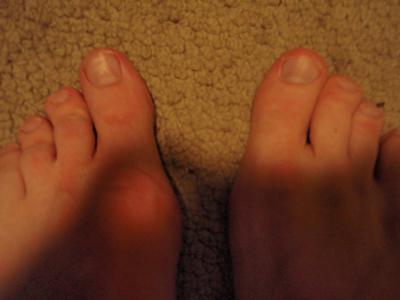 Bunions involve boney prominences and repositioning of the joints at the base of the big toes. Bunions most commonly affect the inner foot at the base of the big toe but also can affect the outside of the foot at the base of the little toe, referred to as a bunionette or tailor's bunion. Bunions most commonly affect women. Bunions may or may not cause symptoms. Treatment of bunions can include rest, icing, alteration offootwear, foot supports (orthotics), medications, steroid injections, and or surgery.
Bunions involve boney prominences and repositioning of the joints at the base of the big toes. Bunions most commonly affect the inner foot at the base of the big toe but also can affect the outside of the foot at the base of the little toe, referred to as a bunionette or tailor's bunion. Bunions most commonly affect women. Bunions may or may not cause symptoms. Treatment of bunions can include rest, icing, alteration offootwear, foot supports (orthotics), medications, steroid injections, and or surgery. Causes
Bunions develop when excess pressure is placed on the tendons and joints of the foot. As a result, the joints can become deformed and unstable. After years of pressure, the MTP joint suffers, leading to abnormal movement and bunions. Bunions are symptomatic of poor foot development (which can be genetic), walking habits, shoes, foot type and other reasons. Women often develop bunions as a result of tight shoes that squeeze the toes together. Bunions can also result from foot injuries, congenital deformities and neuromuscular disorders. Flat foot and low arch problems are often precursors to bunions, as are problems with serious arthritis or inflammatory joint disease. An overlap of the first and second toes often causes irritation and corns and can eventually lead to bunions. Poor motion of the big toe can also be a factor.
Symptoms
Alteration in alignment of the first toe. Pain in the 1st toe joint with movement. Restriction in range of demi pointe. Inflammation of the 1st toe joint. Rotation of the big toe so that the nail no longer faces upwards. Occasionally bruising of the toe nail occurs.
Diagnosis
X-rays are the best way to determine the amount of deformity of the MTP joint. Blood work may be required to rule out other diseases that may be associated with bunions such as rheumatoid arthritis. Other tests such as bone scans or MRI's are not usually required.
Non Surgical Treatment
Currently, no strong evidence points to the best treatment for bunions. But in most cases, you can treat them at home. This includes taking medicine you can buy without a prescription to relieve toe pain. It also helps to wear shoes that do not hurt your feet. For example, avoid high heels or narrow shoes. You can wear pads to cushion the bunion, and in some cases, you can use custom-made shoe inserts (orthotics). Avoid activities that put pressure on your big toe and foot. But don't give up exercise because of toe pain. Try activities that don't put a lot of pressure on your foot, such as swimming or bicycling. Surgery to correct a bunion may be an option if other treatment does not relieve pain. There are different types of surgery for bunions. You and your doctor can decide which one is best for you.

Surgical Treatment
If the conservative options fail, your doctor will determine the best surgical procedure based on the severity of your condition. The most common surgical procedure is a bunionectomy, which includes removing swollen tissue from around your big toe joint. Removing part of the bone to straighten your big toe. Realigning the metatarsal bone to reduce angular deformity. Joining the bones in a corrected position to permanently correct the deformity. Most people can get up and walk around the day after bunion surgery, but full recovery can occasionally take up to eight weeks or more. Doctors stress the importance of wearing proper shoes, especially after treatment, to prevent recurrence. If you are at higher risk or prone to bunions, you may not be able to avoid recurrence.
Prevention
To minimize the chance of developing bunions, never force your feet into shoes that don?t fit. Choose a shoe that conforms to the shape of your foot. Opt for shoes with wider insteps, broad toes, and soft soles. Shoes that are short, tight, or sharply pointed should be avoided.